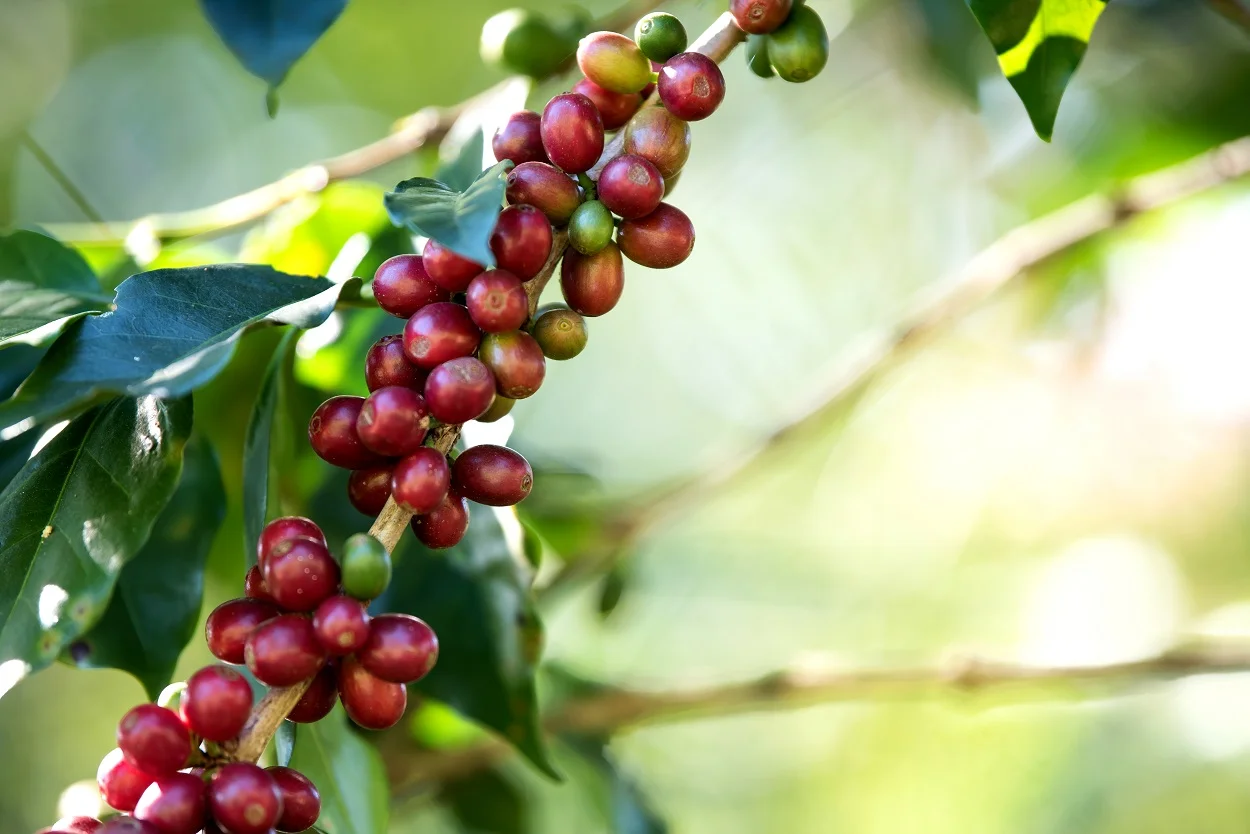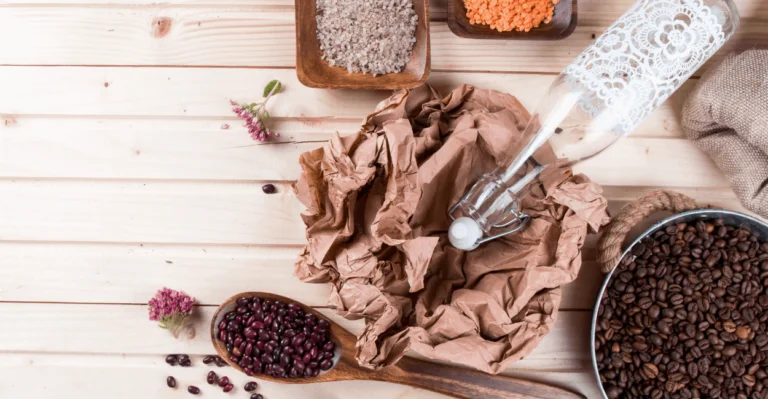How To Plant And Grow Coffee At Home
One of becoming trend nowadays is how to plant and grow coffee at home. In particular, this practice is more common among homeowners who live in areas with favorable coffee plant growing conditions.
However, most people still wonder how to grow a coffee plant and care for it until it yields.
The truth is, growing and caring for coffee plants is not a difficult task at all. With good care, coffee plants will grow fast and give you outstanding results.
Grown up coffee plants normally have small white flowers with a sweet jasmine-like fragrance. So, if you have a coffee plant in your home, you will enjoy the sweet fragrance when they produce flowers.

But the need for growing coffee goes beyond the fragrance; for most people, learning the essential tricks like growing coffee at home is satisfying at the very least. It feels great when you accomplish something beneficial for you and your family.
If you want to learn how to plant and grow coffee at home, you have come to the right page.
Read on to learn the basic things you should know about growing your own coffee!
Learn on How Plant and Grow Coffee At Home
Yes, you can grow coffee at home, as long as you have the right coffee plant information and tips for coffee growing.
Having the right information about how to plant and grow coffee at home, will keep you motivated to care for the plant.
While growing coffee may seem hard, most people who have done it at home reveal that it’s doable.
But some of them swear never to do it again. Perhaps, they get overwhelmed, or they lack essential coffee-growing information.
One of the things that scare many people away from coffee growing is the extraction of beans, as it can be time-consuming.
When you know that the coffee plant is one of the best fruiting plants indoors, you won’t hesitate to learn how to grow a coffee plant indoors.
Continue reading to discover more about coffee growing!
How Long Does a Coffee Plant Take to Bear Fruit?
Another question that pops in the mind of a homeowner who wants to grow coffee is how long it takes a coffee plant to bear fruit.
Well, depending on the variety you choose to grow, it will take 3 to 4 years for a newly planted coffee plant to produce fruits.
Coffee fruits are known as coffee cherries, and they turn a bright, deep red when ripe and ready to be harvested.
If you want to grow coffee indoors, the most recommended coffee plant is the Arabica coffee plant.
Arabica coffee plant has rich, sleek, deep green leaves that are easy to maintain. It makes an exceptional potted indoor house plant.
The evergreen Arabica coffee plant does not shed its leaves so often. So, you can be sure that caring for this plant is super easy.
Should I Keep My Coffee Plant Indoors or Outdoors?
This question is another common concern aside from the question o how to plant and grow coffee at home especially for first-time coffee plant growers.
The answer to this question depends on various factors like your needs, available space, and goals.
Some people choose to keep their coffee plant in a greenhouse sunroom, outside the house, or at door entrances.
Those growing more coffee plants do it on the farm, especially in the rural areas. Therefore, if you want to grow more coffee for selling, you should have a good site.
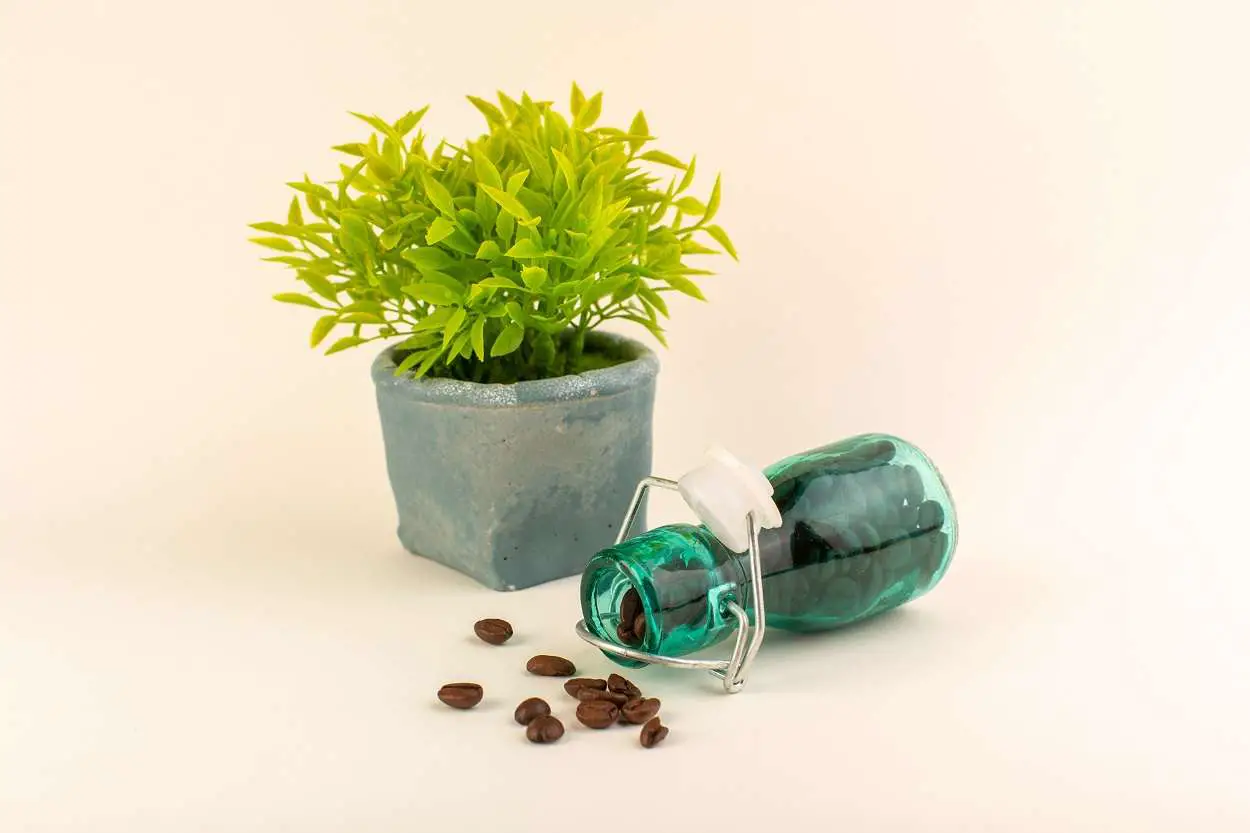
But if you are doing it just for home aesthetics or because you love coffee plants, you can conveniently plant your coffee in the pot.
The good thing with the coffee plant is that it’s a shade-loving tree and needs a little sunlight. Hence, it will still be useful even when potted indoors.
You can have several coffee seedlings in the pot and then separate them as they grow.
Whether you choose to grow it outdoors or indoors, a coffee plant usually grows to 5 to 8 feet.
Can You Plant Coffee Beans and Grow a Tree?
Coffee beans are basically the seeds of a coffee plant.
Inside each coffee cherry, there are two coffee beans. If you want to grow coffee from seed, it is wise to find fresh coffee beans. Don’t plant roasted coffee beans.
Roasted coffee beans won’t give perfect results if you are after a lovely coffee plant that will produce fruits.
Roasted coffee beans are used to brew coffee and not to be planted.
It will help if you find fresh ripe red coffee cherries to obtain coffee beans for faster germination
Coffee seeds obtained from dry harvested unroasted berries could take a long time to germinate.
Generally, fresh seeds take two and a half months to germinate while old and dried seeds will take four to six months.
Where To Buy Coffee Plants
You can buy coffee plants from big box stores, home improvement centers, and grocery stores.
You can also order the best coffee plants from online stores like Amazon. You should also ensure that you buy seedlings from a fresh and recent crop.
Coffee plants are often sold in three or four pots, and they are usually 3 to five inches tall.
One pot usually comes with multiple coffee plants, about four to six in the pot.
Go for coffee plants with glossy and undamaged leaves and a compact appearance.
Then you can replant your coffee plant into a larger pot when it reaches 6 inches in height, or plant them on a prepared piece of land.
If you want to separate the multiple coffee plants into different pots, fill the container with warm water and leave it for a few hours to soften the soil.
When the soil is soft and moist, it makes it easy to separate your seedlings. Then slowly pull the seedlings apart and repot them.
How To Grow Coffee From Seeds
If you don’t manage to find a potted coffee plant in the nursery, you can still grow coffee from seeds. Thus, it is also essential to learn how to grow a coffee plant from seed or coffee beans.
Here are the steps for growing coffee from coffee beans:
Step 1
Soak the coffee seeds in water for about 24 hours for pre-germination. Pre-germinating the seeds will promote fast germination. Then prepare a moist and acidic soil where you will plant your coffee beans.
Step 2
Sow the seeds in damp and sand or wet vermiculite, which does not have excess water. Note that coffee seeds do well in loam soil.
Make sure the soil has high humus content, rotted manure, or bone meal.
Once you sow the seeds, cover the soil with mulching grass, about half an inch, to conserve moisture.
Mulching will also prevent soil erosion.
You can also place the seeds between moist coffee sacks and water it twice a day and drain well.
For subtropical and tropical regions, you can plant your coffee seeds anytime throughout the year. You should also keep in mind that coffee plant hardiness zone is 10.
The best time to sow your coffee seeds is in spring to mid-summer.

Step 3
After your seeds have germinated, you can now remove the mulching grass since you are about to start watering your plant.
It is better to keep the plant in partial shade, allowing it to receive only the morning sun.
If you planted your seeds on the ground, you could transfer the plant to a plastic or a clay pot or any other plant container.
Step 4
Find out the optimum growing temperature for the type of coffee plant you’re growing.
The optimum growing temperature for the Arabica coffee plant is between 53° F to 80° F (12° to 25° C)
Then keep your plant at the most favorable place based on its growing temperature.
Ensure that you find a place where the temperature does not often fluctuate to avoid leaf shedding.
You may consider planting your coffee plants under avocado trees if you have them on your farm.
Read More:
Best Soil for Planting and Growing Coffee
Keeping in mind that the coffee plant has tap roots, it is crucial to find a site that will allow the roots to go straight down into the soil.
The best coffee plant soil is the soil that promotes proper root penetration.
You can boost the soil structure by spreading manure around the base of the coffee plants.
If your yard is composed of a hard-top layer soil, you should break the hard layer first.
It is wise not to remove all the trees when clearing the site since coffee trees do well with less direct sunlight.
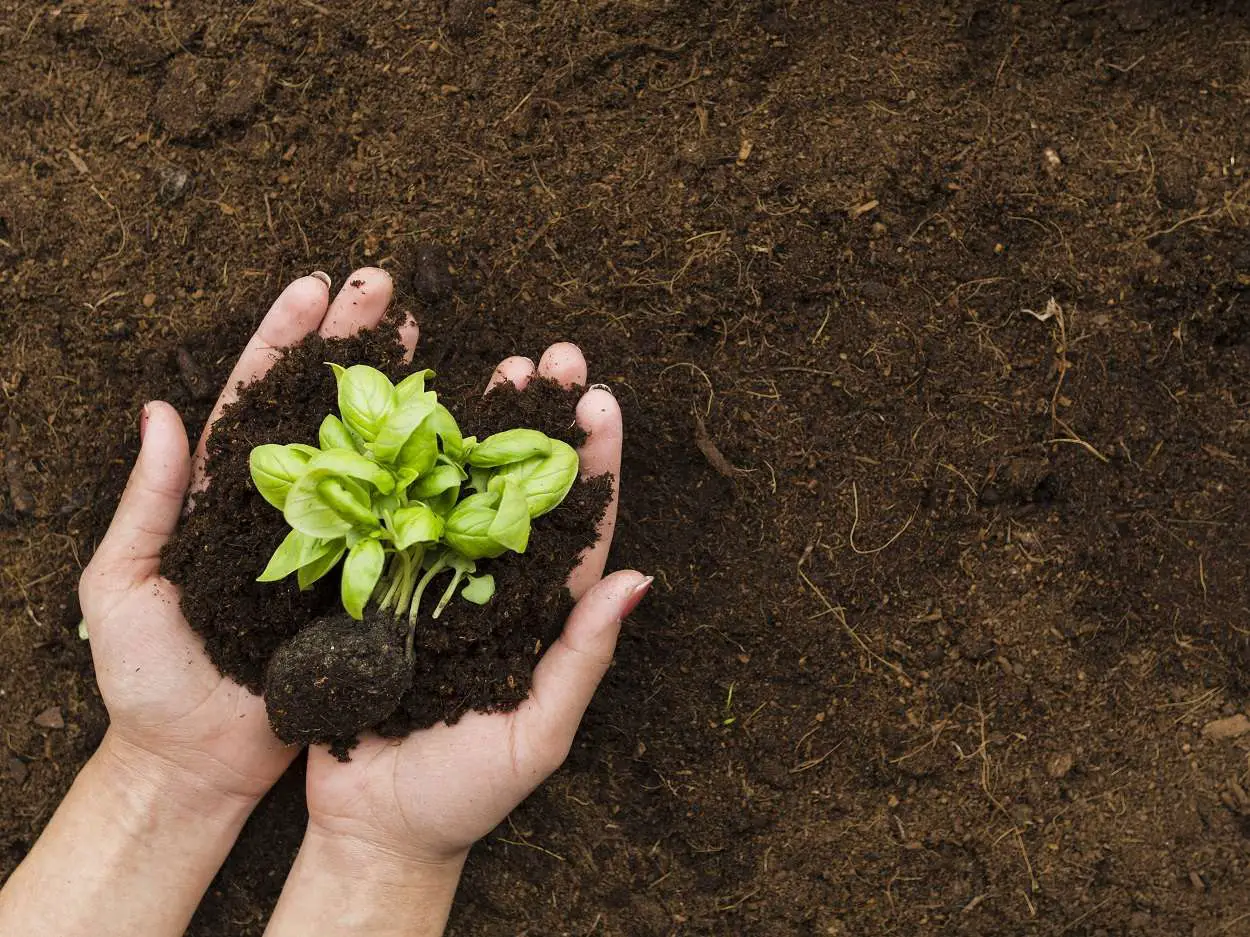
Coffee plants can grow in various soils, but the most suitable soil types are fertile volcanic red earth or deep sandy loam.
It is critical to ensure that the soil you are planning to grow your coffee has good drainage. Soil types like heavy clay and heavy sandy oils are inadequate for coffee growing.
Coffee plants will not do best when planted on limey soils. The best soil pH for coffee growing is 4 to 7.
Don’t forget that lots of compost will be beneficial to your coffee plants.
Coffee plants will not do best when planted on limey soils. The best soil pH for coffee growing is 4 to 7.
Don’t forget that lots of compost will be beneficial to your coffee plants.
Best Coffee Plant Fertilizer
While they take quite a while to mature, coffee plants are heavy feeders. They are nutrient hogs.
Young Arabica or Robusta coffee trees need more Nitrogen as the plant is building a root system.
The stems are also growing, and the coffee plant is holding a lot of leaves that require nutrients.
Best fertilizers for medium coffee plants include Super Phosphate, Rock Phosphate, and KCI growing mixture.
You can boost your coffee with foliar spraying with Multi-K, which is the most effective way to improve potassium and nitrogen uptake.
With proper pruning and weeding, you can maximize your potential yield by fertilizing the soil with the relevant fertilizers.
Developing the proper fertilization program based on time and rates can help in making a reliable yield estimation.
If you don’t give fertilizers to your coffee plant, the leaves will turn yellow and will begin to fall.
How Often Should I Water A Potted Coffee Plant
Coffee is a rainforest plant that does well in places with high humidity and hence is a water lover. Thus, you should water your plant regularly.
If a week passes before you water a potted coffee plant, it may be damaged.
Water your plant thoroughly but don’t allow the plant to sit on the water.
You can drain the excess water after watering to keep the soil moisturized but not waterlogged.
This makes the watering even more quickly and keeps the soil moisture more consistent. You can plant using the sub-irrigation planter or install an automatic plant watering system.
Nonetheless, how often you should water your potted coffee plant depends on several factors. These factors include;
1. The Current Container and the Plant Size
The container you have planted the coffee in determines the amount of soil and water you should use. If the container is small, you should water more often than when the container is big.
2. Humidity in The Plant Location
In places where the air has little moisture, the plant will lose a lot of water to the environment through transpiration.
You should water your plant up to two times a day where there is low humidity and once a day where there is high humidity.
3. Season
Potted coffee plants should be watered at least twice a day during the dry season and once a week during the wet season.
4. Plant Age
Young plants should be watered several times a week and almost half that rate for older plants
5. The Type of Soil and Container
Different types of soils have different abilities to retain water.
Soils with larger particles lose moisture quickly and therefore dry faster. If you have used ground that loses water quickly through evaporation, you should water the plant more often.
How to Prune a Coffee Bean Tree
The coffee tree grows too fast within a few years. It uses much of its nutrients to make wood and branches.
After they start bearing, the branches can give you many berries, but they begin to age with time. It will now start to use more mineral salts from the soil to maintain and build its wood with reduced yields.
Therefore, it is important to prune these trees to maintain a good shape, increase the yields, and make the harvesting easy.
Pruning Different Coffee Plant Varieties
Arabica coffee and other types similar to it have one main stem and berries grow on its branches. It is pruned using the following steps;
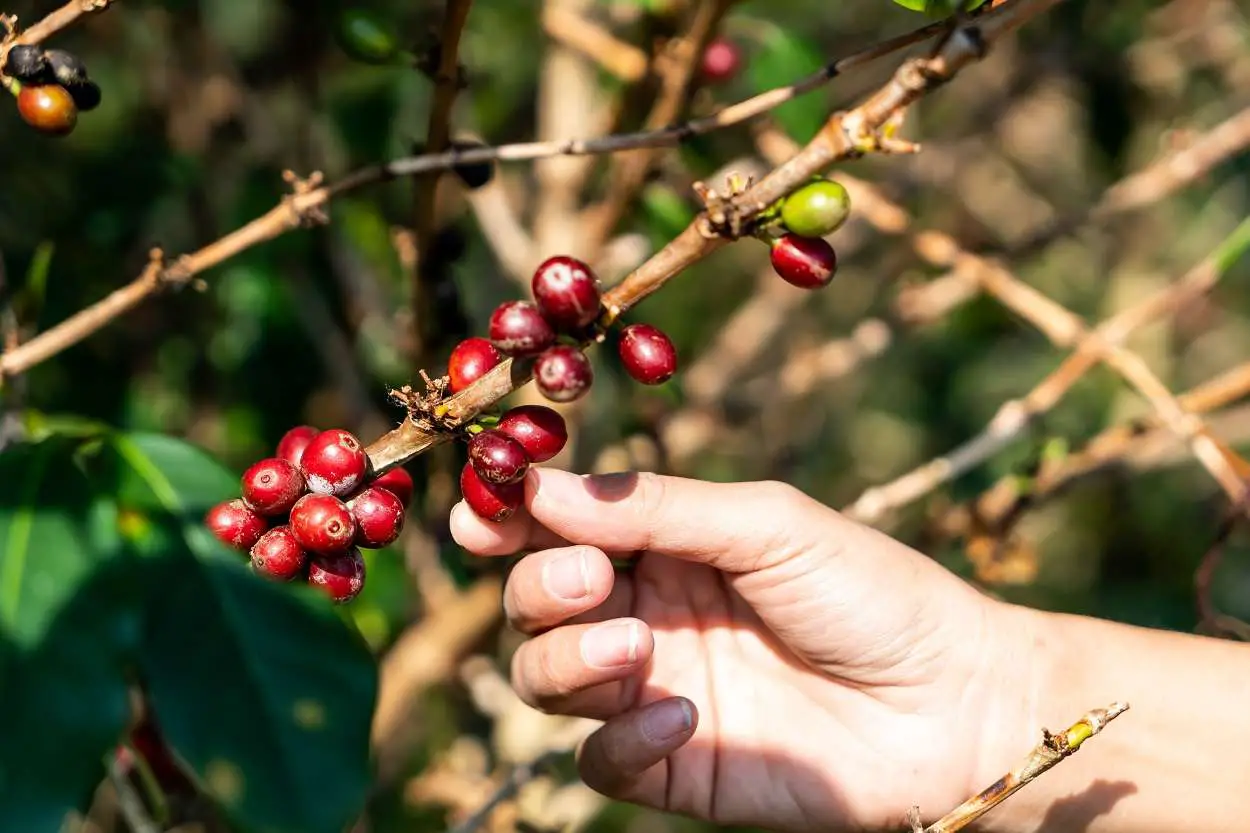
- Cut the tot of the coffee tree in that the remaining is not taller than 2 meters
- Remove all the branches at the tree’s trunk
- Cut all the small branches leaving only the thickest branches
- Remove all the dead, dry, and diseased branches, whether thick or small.
- Remove all the suckers that are the base of the coffee plant since they are not needed.
The Robusta and its varieties have many main trunks and several trunks. Pruning these types of stems is difficult because of the following reasons;
- Some branches of this coffee plant bear berries for one year and give nothing next year
- Other branches produce berries for many years but it’s only in some parts and not the whole branch
The Robusta coffee plant is pruned in the following steps;
- Start by taking one branch and tie it to the stake of a nearby stump
- Let around five main stems grow on the bent branch, which will bear good fruit
- Cut the bent stem, and other new branches will grow in its place
- Branches will grow on the main stems, and they will bear fruit. After around two years harvest, cut them down too.
- When the main stem has berries for five years, you should cut it off, and a new stem will grow from it.
- You should cut at least one stem every year
- Cut all suckers since suckers never bear fruit
- Just like for Arabica, cut all the dead and dry branches from your coffee tree.
Coffee Plant Care: Indoor Coffee Plant
For experienced gardeners, caring for coffee plants is an easy task.
However, beginners may find it hard to provide care for coffee plants. But with the right tips, it becomes a simple thing to handle.
If you love houseplants, it is essential to learn how to grow a coffee plant indoors and outdoors.
In the summer season, coffee plants need a climate that provides bright filtered light.
This is the lighting your indoor coffee plant will get when growing behind a sheer curtain-filtered light.
The indoor coffee plant will grow well when they receive the morning sun. You should not keep your potted coffee plant in a location that has direct sun throughout the day.
Coffee Plant Care: Outdoor Coffee Plant
During summer months, you can plant coffee in the garden or the yard. You can also grow your coffee under other big trees.
These three tips will help you while growing coffee outdoors:
- Water the plant regularly and keep the soil moist
- Use manure and feed the plant with fertilizers
- Provide light shading and avoid direct sun on the coffee plant
Cherry Picking and Roasting
When the cherries ripen, you have to pick them from the tree, with a simple twist and pull.
Once you harvest your coffee cherries, you will want to prepare them for roasting.
You can pop your cherries at home, one-by-one, or put all your cherries in a bucket and smash them to obtain the seeds.
Some people use ovens for the coffee roasting process, but it is recommended that you have a purpose-built coffee plant roaster.
You can check some coffee plant roasters menu online if you are doing it for the first time. For instance, you can find some good coffee roaster menu videos on YouTube.
Coffee Plant Varieties
There are many varieties of coffee grown all over the world. However, the leading coffee varieties are the Arabica and Robusta. Other types include the Kona coffee, Bourbon, and many others.
Coffee Robusta
This type of coffee beans is grown at lowlands and is of lower grade than the Coffee Arabica. They are easy to maintain, disease-resistant, and produce higher yields. This type of coffee has higher caffeine amounts and has an astringent flavor.
Coffee Arabica
The Coffee Arabica has pleasing flavors and many aromatic properties. This type of coffee has a lower amount of caffeine as compared to Robusta.
Many of the coffee Arabica varieties are named from their place of origin.
Arabica also has a slower growth rate and is mainly planted in the mountains and highlands. Here are some varieties of Coffee Arabica:
i) Columbian Coffee
The Columbian coffee is a subtype of Arabica but is a bit weaker than other Arabica coffee types.
i) The Dwarf Arabica Coffee
The dwarf Arabica coffee is more suited for home coffee growing. These coffee plants remain small and start to bear cherries after three to four years.
They are very ideal for your living room since they are small. You can plant them anytime of the year.
Coffee Propagation from Cuttings
Propagation coffee from cutting is similar to propagating other plants from cuttings:
- Prepare coffee cuttings from an existing coffee plant
- Take a small pot where you will plant the cuttings and prepare it by filling it with a potting medium, a mixture of perlite and peat.
- Plant the cuttings in the pot and water it evenly, not soaking wet.
- If you see any new growth sign, transfer the plant to a bigger pot and water it well.
Dealing with Pests and Other Problems
While coffee plants are robust houseplants, some agricultural errors could lead to problems.
Most problems associated with coffee-growing include:
Green leaves dropping off: This condition occurs when the coffee plant is kept in the dark location.
Brown leaf edges: This usually happens when the Arabica coffee plant is exposed to too much sun.
Withering leaves: Coffee plants’ leaves will wither when the temperatures are very high. They may also lose their glossy look.
You can control fungus infections by reducing water, but don’t let the plant dry out. Neem oil comes in handy for controlling major fungus infections.
Another issue with coffee plants is pests that hide under the leaves. Luckily, you can handle pest attacks with alcohol and a swab and other mineral spraying oils.
Conclusion
Growing coffee can be a rewarding endeavor. Once you learn how to plant and grow coffee at home, you will enjoy planting coffee in your yard or indoors.
Besides, coffee plant care is effortless and convenient. When your coffee cherries mature, harvest, pulp, dry, and roast them and enjoy the coffee!

